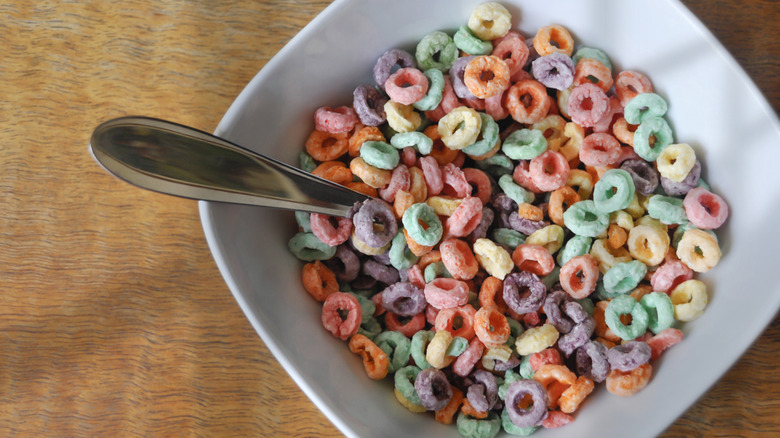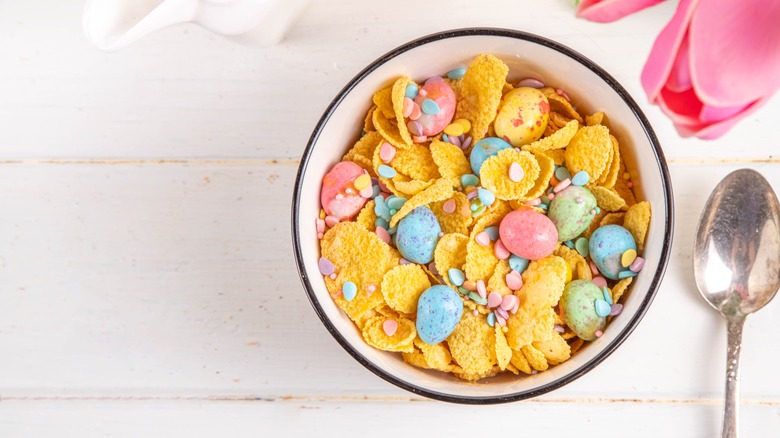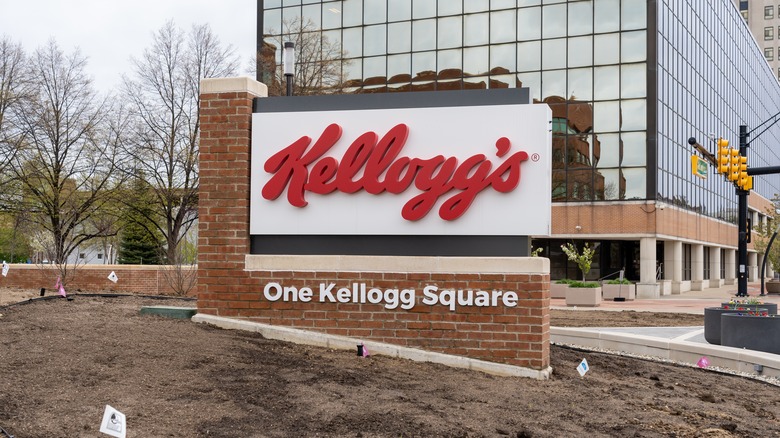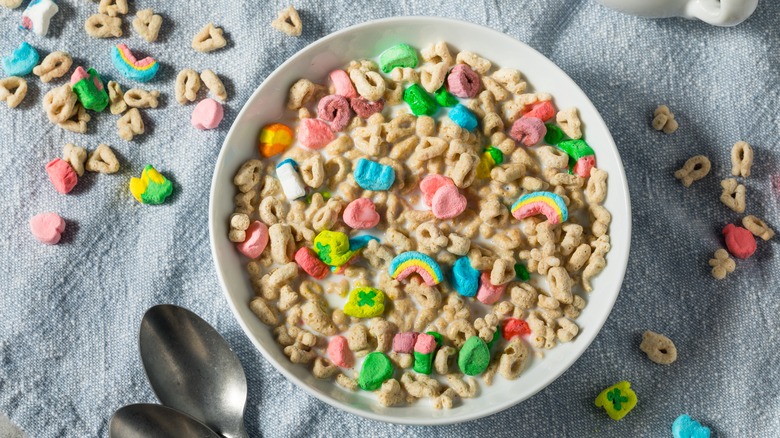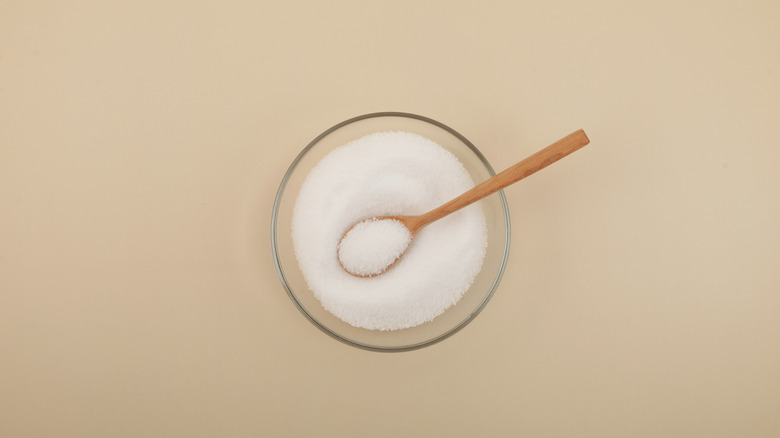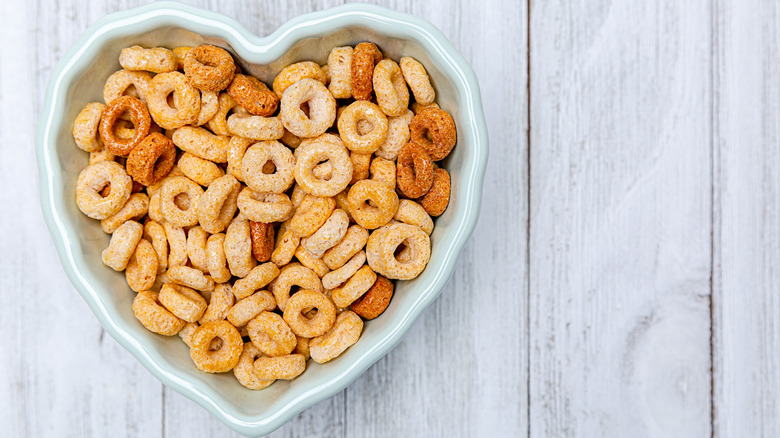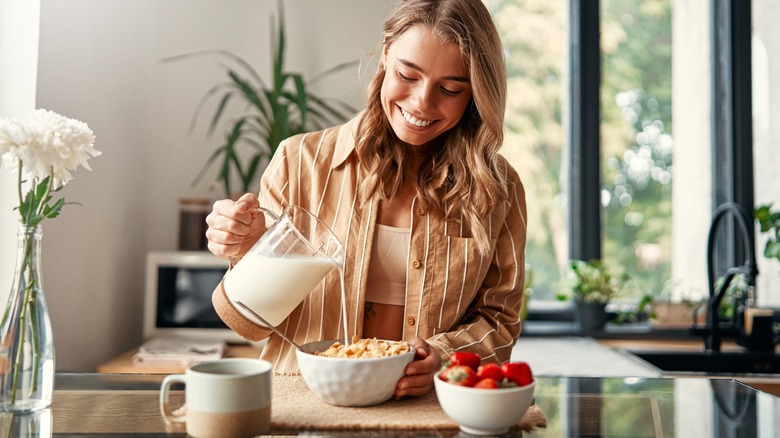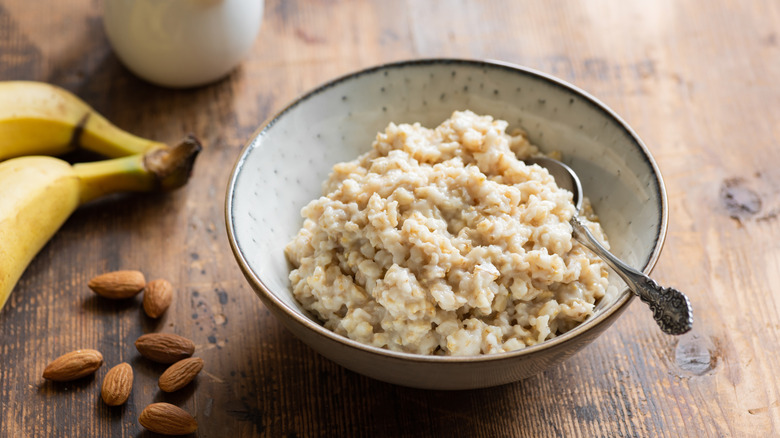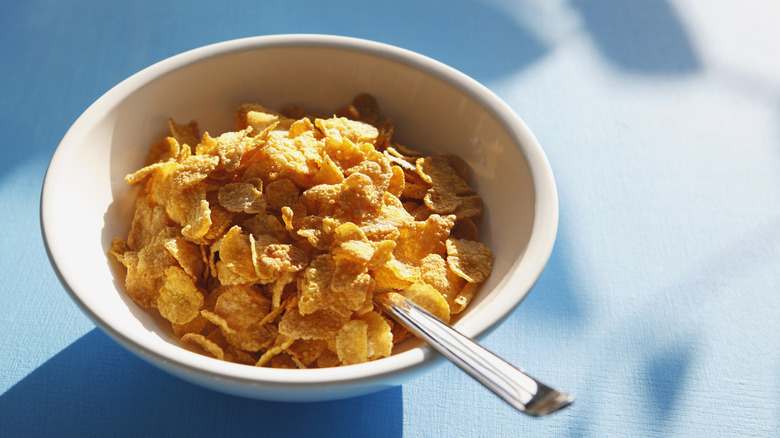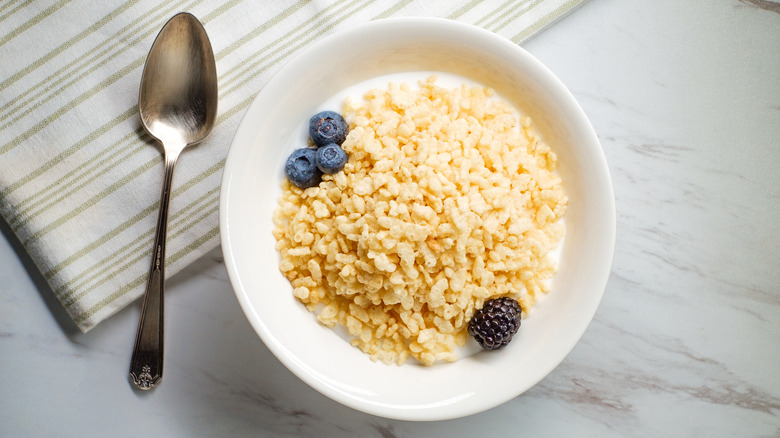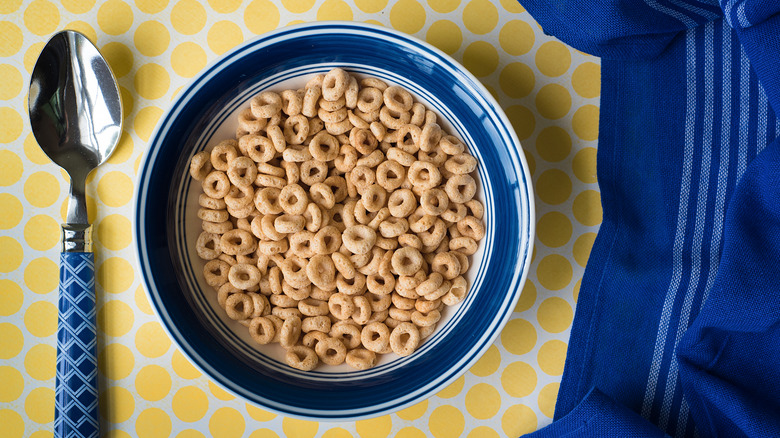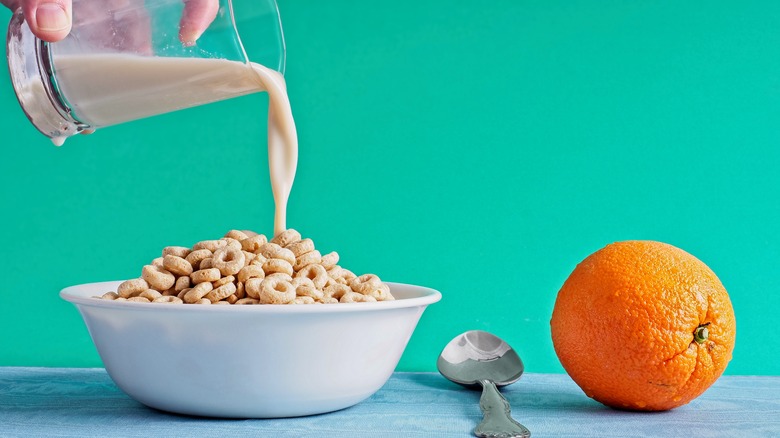12 Of The Biggest Cereal Myths Debunked
What did you have for breakfast this morning? It was cereal, wasn't it? Hey, no need to be embarrassed — we had cereal too. There's a reason we're still all eating this breakfast food, which was invented way back in 1863: It's a tasty, speedy, fuss-free way to start your day. Although eating trends have changed considerably since the heyday of ultra-sugary neon pebbles in bowls around the country, the breakfast cereal market was still valued at an incredible $82.16 billion in 2024, according to Statista. What's even more incredible is that with all of that cash being splashed around, we still don't entirely know the facts. There are a lot of things we still don't know about cereal, and that's led to a lot of myths, y'all.
Well, it's high time that we set the record straight. Contrary to popular belief, cereal is not always laden with sugar; but nor are the sugar-free ones healthier for you. Cereals aren't all highly-processed either — but nor are they always full of the nutrients you need. Cereal doesn't even have to be cold, or just for breakfast, or served with milk. Confused? Don't worry. Once we've separated myth from reality, you'll know the facts about this timeless breakfast dish like the back of your hand.
1. Myth: All cereals are full of sugar
Ask anyone you know what the unhealthiest thing about cereal is and they'll likely tell you that it's that they're full of sugar. We're not going to lie, that's definitely true of some of them — but the idea that they're all sugar-packed and always have been is completely false. Cereals only started to get really sugary in the 1950s, when sweeter versions of them began to appeal to customers. Before then, cereals were relatively modest affairs, with regular puffed rice and wheat flakes dominating the market.
Once cereals became sugary, there was definitely an uptick in ultra-sweet varieties designed to appeal to kids. However, by the time the 2000s rolled around, customers were looking for healthier options once more. Nowadays, there are dozens of cereals out there that are relatively low in sugar, with a lot of high protein breakfast cereals being totally sugar-free. There are also varieties out there that supply a few grams of sugar per serving, but won't necessarily tip you into unhealthy territory, provided that you're sticking to the suggested serving size. Having said that, there are still a lot of cereals you should avoid eating. Keep an eye on the added sugar content of your chosen brand. If it starts to get close to double digits or significantly eats into the suggested added sugar allowance of 25 and 36 grams per day for women and men, respectively, you should pick another box.
2. Myth: Kellogg's invented cereal
Think cereal, and you likely think Kellogg's. The company has dominated the cereal market for generations, and the man behind it, John Harvey Kellogg, is frequently credited as the person who invented cereal in the first place. That's not entirely true, though. What is true is that John Harvey Kellogg invented Corn Flakes in the 1890s, and was partly driven by a belief that bland food would keep Americans away from sin. However, cereal itself was actually invented in 1863, by a man called James Caleb Jackson. His cereal was called "granula," and honestly, it sounds pretty unpleasant.
Granula (sound familiar?) was a dry, brittle cereal that was a little like Grape-Nuts. Granula was made from baked graham flour that had been processed down into little pebbles, and to eat it you had to soak it in milk overnight so that it softened up enough to be edible. It's probably no surprise that it didn't take off, but the idea of mixing cold, dry pieces of food with milk caught John Harvey Kellogg's eye, who began to make a "granula" of his very own. After Kellogg was sued by Jackson, he changed his cereal's name to... you guessed it... Granola.
3. Myth: All cereals are highly processed
Cereal has gotten a bad rap over the last few decades, and to be quite honest, we get it. If you've ever taken one look at a bowl of Lucky Charms (which once had an ill-fated mascot, Waldo) or Froot Loops, you'll know that these foods aren't exactly farm to table, with their source ingredients processed beyond all recognition. However, it's not true to say that they're all highly processed. There are plenty of healthy cereals that taste good and go through pretty minimal processing. Take muesli, for example. Muesli is a raw mixture of oats, dried fruits, nuts, seeds, and other ingredients — and while some individual ingredients within it go through some basic processing, many brands keep things simple and have no flavor additives, preservatives, or added colors.
Other cereals may be centered around one ingredient that's been minimally processed, like puffed rice. Although some puffed rice brands may have additional ingredients, others keep the processing side of things down to just the puffing of the rice itself, which is done by heating rice kernels under pressurized conditions, and have no additives. Having said all this, you should keep on the lookout for cereals that feel like they're less processed than they actually are. Some types of granola may seem healthy, but can still be highly processed and contain loads of extra additives.
4. Myth: Sugar-free cereals are healthier for you
There's a general rule of thumb when it comes to breakfast cereals: Those that have sugar are unhealthy, and those that don't have sugar are more nutritious. That doesn't quite hold true, though. Although some sugar-free cereals can be healthier through their sheer lack of sweetener, others try to emulate that sugary flavor with artificial additives. Oftentimes, they add sucralose into their formulations, which may create further potential issues.
Sucralose, which has long been sold as Splenda, may help you cut down on your sugar intake. However, some studies have shown that swapping out sugar-sweetened items for artificially-sweetened ones may cause us to consume more calories in the long run. While this is generally seen to be the case with people who drink diet drinks instead of full-fat ones, it could also be the case that eating sugar-free foods allows us to justify eating more, or increases our cravings. As well as this, sucralose has been observed to potentially upset our microbiome and therefore affect gut health, and potentially produce higher levels of inflammation throughout the body. Naturally, this doesn't mean that you should embrace sugar-filled cereals instead of sugar-free ones. It's important to remember what effect your dietary swaps may have, though.
5. Myth: All cereals are a good source of fiber
If there's one thing cereal has up its sleeve nutritionally, it's fiber. Countless cereal boxes proudly state that the product inside is high in fiber, and over time we've come to assume that most brands supply a healthy dose of the essential nutrient. That couldn't be further from the truth. In fact, there are a lot of cereals out there that are incredibly low in fiber, and even some of the most popular cereals in the US like Cheerios, Rice Krispies, and Special K provide barely any per serving, with Special K having less than 1 gram in each bowl.
This lack of fiber could be more of a problem than you think when it comes to cereals. Getting a good amount of fiber first thing in the morning can help level out your blood sugar, preventing you from getting a big spike of glucose and keeping you full for longer. If you eat a sugary cereal without any fiber in it, the opposite will happen: Your blood sugar will go through the roof, and you'll be hungry again in an hour. So don't just assume that your cereal has fiber in it, even if it is marketed as a healthy choice. Check the nutritional label carefully.
6. Myth: Cereal is only suitable for breakfast
Okay, so this one may not be a total myth anymore, but there was a time when if you suggested that you were going to eat cereal past 10 a.m., people would give you a strange look. However, the idea that you can only eat cereal at breakfast is not only untrue, but denies the joy of it at other times. A bowl of cereal can be eaten as an after-school snack, a dessert, or a little amuse bouche before lunch, or even a light dinner. It's the perfect thing to whet your appetite between meals, or to munch on while you read this article.
That's all before you consider how you can eat cereal outside of a bowl, too. Cereal can be popped into a peanut butter sandwich for extra crunch, or used as part of a snack mix. You can use it to top a parfait or scatter it over baked brownies. You can make an ice cream sandwich with cereal, giving the creamy dessert a little extra flavor, or use it to crust fried chicken, or perhaps top a hearty mac and cheese...it can go as far as your imagination will take it.
7. Myth: Cereal is always cold and crunchy
Cereals pride themselves on their snap, crackle, and pop, with a crunchy consistency that's served drenched in cold milk. The idea that they're always cold and crunchy, though, is false. Hot cereal is very much a thing, and you've likely had it in the form of oatmeal. While you might not think of it as a cereal because it's warm and soft, it's made out of a cereal grain, and can therefore be classified as one.
As rice is a cereal grain, other types of porridge like congee can also be considered a hot cereal. Things don't stop there, either. Grains like amaranth, millet, and farro can be made into hot cereals, and provide you with a truckload of nutrition to boot. Even grits, which are made from cornmeal, are technically a hot cereal too. Once you realize this, it also becomes clear that hot cereals don't need to be sweet — they can be savory too, and all the more delicious for it.
8. Myth: All cereals are high in carbs
Cereals are often associated with a few key nutritional factors, mainly carbohydrates and sugar. That makes sense, given that they're made out of carb-filled grains like wheat or rice, and often sweetened with sugar or corn syrup. However, this doesn't mean that all cereals are high in carbs. As a matter of fact, there are plenty of low-carb cereals out there that deliver just a few grams of net carbs per serving, and which often provide a fair bit of protein too.
These cereals can be made from a combination of plant proteins and fibers, which has the dual combination of giving them bulk and making them more filling. Many of them are appropriate for keto diets, and can have a slightly higher fat content that can keep you fuller for longer. Some low-carb cereals are sweetened with monk fruit extracts, but they can also contain sweeteners like stevia or allulose. There are even low-carb hot cereals out there, made from a combination of organic coconut and ground nuts and seeds. The modern world is pretty amazing, huh?
9. Myth: The vitamins in fortified cereals are less useful
Many of the cereals that adorn our shelves have been processed, but it's important to note that this processing isn't always a bad thing. Cereals commonly have vitamins and minerals added to them to make them healthier and help restore any nutrients lost during the processing procedure. However, somewhere along the way, the idea that these vitamins were somehow not as good for us as vitamins from whole foods began to appear. This may have been rooted in the fact that other, more processed forms of vitamins, like multivitamins, aren't necessarily all that beneficial due to the low bioavailability of the nutrients inside.
Luckily, this isn't quite true. Fortifying foods has been proven to be an effective way to top up vitamin and mineral intake. Fortification can even lead to significant reductions in various diseases, in areas or populations where vitamins and minerals from other food sources aren't readily available. While it's always a good idea to try and get these nutrients from whole food sources in your diet, it's comforting to know that the vitamins and minerals added to cereal does have an effect, and isn't just a marketing gimmick.
10. Myth: Gluten-free cereals are healthier
Ah, the gluten-free myth. It rears its head every time. Now, let's get one thing out of the way: If you have a gluten intolerance or celiac disease, it's 100% the case that opting for gluten-free cereals is a good idea. However, with the massive rise in gluten-free foods available out there, an idea started to develop that eating gluten-free items when you don't have a gluten intolerance will somehow be a healthier choice.
We're here to state, once and for all, that that's a myth. Eating gluten-free cereal when you don't have a gluten intolerance will likely have no significant positive impact on your health. In fact, opting for gluten-free food choices can often lull you into a false sense of security. It's easy to presume that these foods are somehow healthier, but many of them are still loaded with sugar and sodium, making them just as unhealthy as foods containing gluten. Gluten-Free Honey Nut Cheerios, for instance, still has 12 grams of added sugar per serving, and just 3 grams of fiber — more fiber than some other cereals, but still not a huge amount. Regular Honey Nut Cheerios contain the same amount of added sugar and fiber, making this a fairly like-for-like swap unless you can't eat gluten.
11. Myth: Cereal only goes with milk
Name a more iconic combo than cereal and milk. It's okay, we'll wait. It's hard to think of two food items that go together as well, but we've got a secret for you: Cereal's been seeing other liquids behind milk's back. Contrary to popular belief, cereal can be eaten with different liquids -– and there's a big market out there for it. It's this realization that led to the emergence of Tropicana Crunch in 2022, a cereal that somewhat feels like it was born out of a fever dream.
Tropicana Crunch was released in line with National Orange Juice Day on May 4, and was designed to offer folks who liked combining their cereal with orange juice a product of their own. By pairing OJ with cereal, you essentially mix two breakfast items in one and end up with a bowl that's sweet and tart. Unfortunately, Tropicana Crunch didn't quite hit the mark with reviewers taking both sides in the debate. Somewhat predictably, Tropicana Crunch didn't stick around for long. That's not to say that it's stopped people mixing OJ with their morning bowl, though.
12. Myth: Cereal is the most important meal of the day
If you're sick of hearing that breakfast — and by extension, cereal — is the most important meal of the day, you're likely not alone. This is something that's been drummed into us from birth, so we take great pleasure in debunking this myth, once and for all. The idea that breakfast matters more than other meals arose during the 19th and 20th centuries, and a combination of the thought that breakfast would make you more productive and advertising lobbyists pushing products pushed it into the stratosphere. A lot of this advertising promoted the fact that cereal was nutrient-rich and fortified with vitamins and minerals, therefore making it essential to eat.
However, the truth of the matter is a bit more complicated. There's no denying that breakfast is important and supplies your body with energy first thing in the morning. However, the idea that you absolutely need breakfast to function optimally is far from conclusive, with studies about breakfast's importance being mixed. At the end of the day, everyone's different, and while some people need breakfast to function, other people prefer to spread their nutrients throughout their waking hours.
